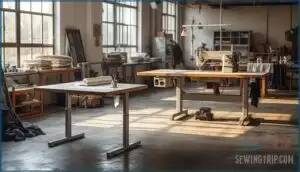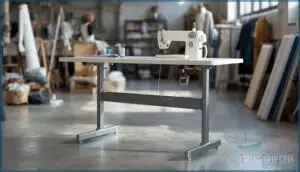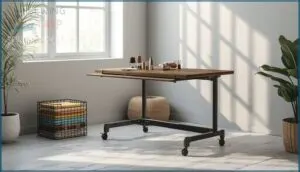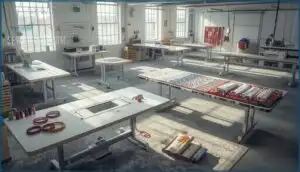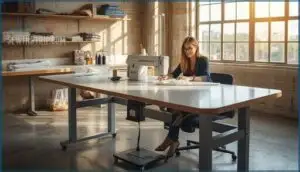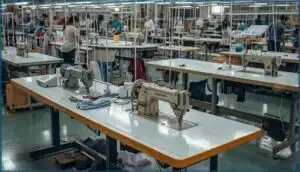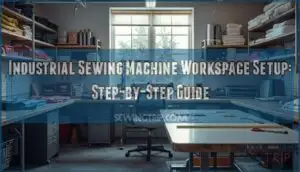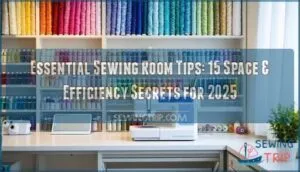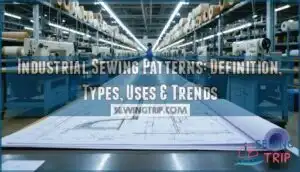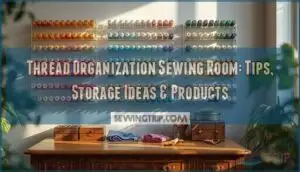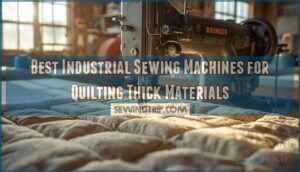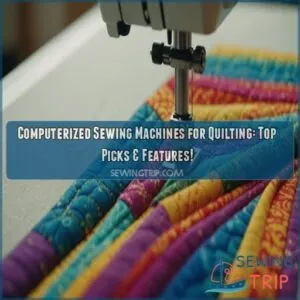This site is supported by our readers. We may earn a commission, at no cost to you, if you purchase through links.
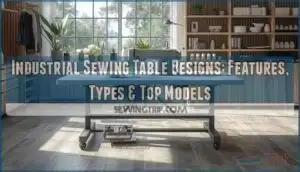 You know the feeling when your machine starts to shimmy across the table mid-seam, threatening to throw your work off track? That’s more common than you’d think—and a sign of a workspace that’s fighting against you, not working for you.
You know the feeling when your machine starts to shimmy across the table mid-seam, threatening to throw your work off track? That’s more common than you’d think—and a sign of a workspace that’s fighting against you, not working for you.
In busy shops or home studios alike, the right industrial sewing table design flips the script, transforming chaos into order and fatigue into flow. Whether you’re after silent motors, clever storage, or that rock-solid balance that makes every stitch count, the details matter more than ever.
Get ready to rethink what your sewing station can do for your craft and your business.
Table Of Contents
Key Takeaways
- Industrial sewing tables with vibration-dampening features and sturdy materials help keep your stitches precise and your workspace stable.
- Built-in storage solutions and modular organization make it easy to keep tools and supplies within reach, boosting productivity and reducing clutter.
- Height adjustability and ergonomic design features, including proper pedal placement and sit-stand options, are essential to operator comfort and long-term health.
- Specialized tables offer compatibility for different machine types, workspace sizes, and project needs, giving you flexibility and control over your sewing process.
Key Features of Industrial Sewing Tables
When you’re setting up an industrial sewing operation, the table underneath your machine isn’t just a stand—it’s the foundation that determines how accurately you can work and how long you can stay comfortable doing it.
The table you choose for your industrial sewing setup is the solid foundation on which your precision and comfort depend
The right table combines structural stability with smart design features that address real production challenges.
Let’s look at the core features that separate professional-grade industrial sewing tables from basic workbenches.
Vibration-Absorbing Materials and Construction
Vibrations wreak havoc on stitch quality, so you’ll want tables built with proper vibration control. Natural rubber and nitrile mounts cut mechanical vibrations by up to 70%, while elastomer-metal hybrid dampers dissipate 85% of vibration energy at high speeds. Sophisticated composite panel use—like PORON microcellular urethane foam—offers material damping performance with loss factors reaching 1.0.
For serious operations, active isolation tech and pneumatic systems maintain sub-5 Hz frequencies, while floor vibration control mats and structural mounting systems prevent transmission between stations, reducing noise by 25 dB(A) under heavy loads. These tables often incorporate rubber vibration dampers to reduce vibrations.
Storage Solutions and Organization
Beyond the shock-absorbing foundation, you’ll need smart storage solutions and organization to maintain workflow efficiency. Over 60% of 2025 industrial tables feature integrated drawer systems for tool storage and quick access to supplies. Here’s what modern sewing room organization looks like:
- Drawer systems with 3–6 inch depths and modular inserts that adapt to changing needs
- Hidden storage compartments and slide-out trays beneath the tabletop, boosting space utilization by 29%
- Modular shelving with adjustable racks supporting 25+ kilogram loads for fabric bolts and equipment
- Thread organization stations with integrated racks holding 30+ pegs and dedicated bobbin organizers
- Mobile carts and lockable caster wheels enabling workspace reconfiguration in multi-use factory environments
These space-saving designs cut material search time by 17%, directly translating to measurable productivity gains in commercial operations.
Tabletop Size and Workspace
Once storage is squared away, your workspace dimensions become the backbone of efficient fabric management. Tabletop width and depth directly affect ergonomic reach and material handling, especially for large sewing projects. With tabletop thickness supporting heavy loads, a generous working space is more than convenience—it boosts productivity correlation, improves stitch alignment, and ensures every piece gets the attention it deserves.
A good sewing table also improves the sewing experience by organizing your supplies.
Motor and Pedal Integration
Now, as workspace limitations fade, attention shifts to motor and pedal integration. Servo motorization delivers rapid response and quiet operation, while pedal ergonomics—think adjustable angles and dual-axis controls—boost efficiency gains and comfort.
Smart controls, builtin motor mounts, and secure foot pedal attachments make installation straightforward, aligning with market trends for responsive, energy-saving setups and simplified operator experience.
Machine Compatibility Options
Sometimes the right industrial sewing table acts as a bridge—seamlessly connecting machine and user. Brand compatibility and universal frames simplify setup, while precision tabletop machine cutout dimensions support a wide range of industrial sewing machines. Custom cutouts for Ultrafeed or specialized heads, plus adaptable motor mounts and frames, make certain your table meets evolving needs.
| Feature | Details | Benefit |
|---|---|---|
| Brand compatibility | Universal frame, bracket kits | Broader machine support |
| Tabletop Cutout | Standard & custom dimensions | Accurate machine fit |
| Frame adaptation | Adjustable inserts, mounting | Motor & model flexibility |
Types of Industrial Sewing Table Designs
Industrial sewing tables come in a range of styles, each built for specific needs and spaces. Whether you’re looking for something traditional, motorized, adjustable, or specialized, there’s a design suited to your workflow.
Here’s what you’ll find among today’s top options.
Stand-Alone and Motorized Tables
Choosing between stand-alone and motorized sewing tables boils down to your workflow. Do you want the plug-and-play simplicity of standalone tables—ideal for quick setup and fewer moving parts—or are you chasing the motorized advantages of integrated speed, power, and industrial motor setup?
Motor mounts add integration complexity, but cost comparison and user preference usually tip the scale toward a purpose-built industrial sewing machine table.
Adjustable and Ergonomic Models
If you crave precision and comfort during long workdays, you’ll appreciate what adjustable and ergonomic models bring to the table. Adjustable height features and workspace ergonomics trim fatigue and boost productivity. Modern design innovations deliver:
- Height adjustability with rapid lifts
- Angled work surfaces for tricky operations
- Reduced musculoskeletal risk
- Proven gains in efficiency throughout the latest market trends
Space-Saving and Foldable Designs
Need your shop to do more with less space? Folding mechanisms and ergonomic performance put space-saving designs in a league of their own.
Portability benefits, from steel locking legs to under-table storage, let you shift layouts fast.
Modern foldable cutting tables double as storage-friendly tables—offering material durability, workspace efficiency, and smart sewing table storage ideas for any small-space sewing solution.
Specialized Tables for Different Machines
Ever wonder what makes an industrial table truly work with your machine? True machine compatibility relies on details: Embroidery Tables boast extra-wide cutouts; Serger Tables deliver steady support for high speeds; Quilting Tables stretch to fourteen feet for long fabric rolls. Universal Tables adapt to any machine head, while Heavy-Duty Tables tackle leather, canvas, and technical textile demands—all delivering specialized industrial sewing table features.
- Embroidery Tables offer extended work surfaces and reinforced cutouts for hooping.
- Serger Tables provide non-slip stability and wide platforms for rapid thread changes.
- Quilting Tables reach up to fourteen feet for expansive fabric projects.
- Universal Tables feature modular designs to support multiple machine heads.
- Heavy-Duty Tables resist adhesives and abrasion for leather or canvas work.
Ergonomics and Operator Comfort
Operator comfort isn’t just nice to have—it’s essential for working long hours at the machine. The right sewing table design can make a world of difference in how you feel and perform.
Here’s what to look for regarding ergonomics and day-to-day comfort.
Height Adjustability and Sit-Stand Options
Imagine your table rising with you—adjustable height systems let operators toggle between sitting and standing in seconds, keeping posture correct and energy up. These Adjustment Mechanisms are no luxury: they’re proven to cut fatigue, improve productivity, and lower injury risk.
Here’s how flexible Ergonomic design reshapes the modern workspace:
| Feature | Impact |
|---|---|
| Sit-stand function | 35% fewer injuries |
| Quick adjustment | +19% Productivity |
Foot Pedal and Legroom Design
Adjustable height systems aren’t just for your seat—pedal height and legroom depth also shape your workspace. An industrial sewing machine table with proper foot pedal placement, ergonomic design, and generous under-table clearance lets you maintain natural posture alignment. With the right adjustment mechanisms, you’ll coordinate your feet easily, keeping both movement and workflow smooth throughout the toughest shifts.
Impact on Posture and Fatigue
Leave your foot pedal set just right and the ergonomic benefits ripple through every stitch. Workspace and height adjustability aren’t small luxuries—they’re the backbone of posture improvement and serious fatigue reduction. When your table height suits your operator experience, the sewing workstation builds workplace productivity through:
- Less neck strain
- Reduced back pain
- Shorter recovery times
- Fewer missed days
Material Choices for Durability and Comfort
Chasing better ergonomics means investing in steel strength and laminate hardness—not just for longevity, but for real comfort at the bench. Thick steel frames shrug off daily rattling, while solid wood or high-pressure laminate tops stay smooth and strong.
Wood composites absorb vibration, and sophisticated coating technologies keep your worktop resilient, clean, and pleasant through years of continuous use.
Industrial Sewing Table Applications
Industrial sewing tables step up to a wide range of jobs across busy factories and tight-knit workshops. These tables handle all sorts of sewing machines and project demands.
Let’s look at where and how industrial tables get put to work.
Use in Garment Factories and Workshops
Every garment factory and workshop depends on industrial sewing table designs built for relentless action. You’ll see production line integration and workflow optimization at their core—think stable surfaces that quiet vibration, wide workspaces for handling bulk, and layouts that optimize space.
Ergonomic impact, quick maintenance requirements, and flexible setups make these tables staples in commercial sewing applications, wherever workspace drives output.
Support for Various Sewing Machines
From custom shops to large production, industrial sewing tables have to match the needs of flatbed, overlock, and walking foot machines. Practical design is essential for:
- Machine compatibility with universal cutouts and mounting options
- Excellent weight capacity for heavy machines and motors
- Dimensional adaptability for varying machine footprints
- Support for specialized machines and dual-pedal setups
Adaptation is everything in your workspace.
Role in Pattern Drafting and Embroidery
Fabric management and sewing precision live or die by your choice of sewing table. Vibration dampening in tables keeps stitch quality tight for embroidery and consistent during pattern drafting and apparel design.
Drafting techniques demand wide, stable workspaces, while embroidery tools stay ready with smart storage. The right embroidery machine workspace fosters smooth workflow and precision from layout to final stitch.
Benefits for Commercial Sewing Operations
Productivity gains anchor the value of industrial sewing table applications in commercial operations. Garment factories see faster output, cost savings, and better labor efficiency when upgraded workstations reduce fatigue and simplify workflow.
Quality control stays sharp—industrial sewing machines paired with stable tables prevent stitch inconsistencies.
Operational safety rises, too, as ergonomic design protects operators, ensuring smooth production for any commercial purpose.
Top Industrial Sewing Table Models
Finding the right industrial sewing table makes all the difference in comfort and results. There are standout models that offer a blend of stability, workspace, and durability.
Here are some top picks worth your attention.
South Shore White Farmhouse Craft Table
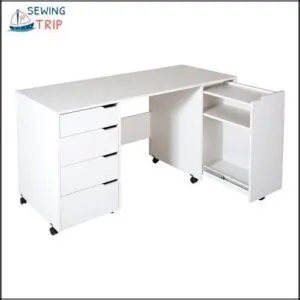
If you’re ready to turn an ordinary workspace into a sewing command center, the South Shore White Farmhouse Craft Table brings a blend of clever storage, sturdy build, and style that stands out in any studio.
You get drawers, sliding shelves, and water-resistant surfaces—ideal for industrious pros craving craft storage, durable country chic furniture, and easy adaptability in modern industrial sewing table designs.
Truecut Adjustable Height Crafting Table
Tired of hunching over projects or wrestling with cramped surfaces? The Truecut Adjustable Height Crafting Table puts you back in control, letting you tailor your workspace for comfort and precision every time.
Smoothly adjusting legs, reliable caster wheels, and sturdy alloy steel guarantee your sewing space stays flexible. This model stands out in Craft Table Reviews for combining crafting ergonomics with smart storage options and easy movement.
Amber Pine Sewing and Craft Table
Sewing projects feel more enjoyable when your workspace is as warm and inviting as the Amber Pine Sewing and Craft Table. Users praise its stable build and foldable leaf—a smart move for Workspace Optimization.
For those chasing top-tier Craft Storage and Sewing Ergonomics in industrial sewing machine table designs, remember to:
- Check table stability,
- Assess sewing table storage ideas,
- Read user reviews.
Modern furniture meets crafting space inspiration here.
Choosing The Right Table for Your Needs
Beyond admiring beautiful crafting furniture, your Table Selection demands practical assessment of your Sewing Space requirements. Consider your machine’s weight—industrial sewing tables supporting up to 60 kg accommodate heavy-duty equipment.
Evaluate storage options for thread organization and material access. Prioritize Ergonomic Design with adjustable height features, as proper Machine Support directly impacts your productivity and comfort during extended operations.
Frequently Asked Questions (FAQs)
How do you assemble an industrial sewing table?
To assemble an industrial sewing table, build the frame from heavy-duty steel using specified bolts, mount the motor securely, attach the tabletop with predrilled hardware, and tighten all bolts.
Use proper assembly tools, check adjustments, and confirm stability.
What is the typical lifespan of these tables?
Built like fortresses, industrial sewing tables routinely endure 20–30 years or more. Table longevity hinges on material selection, build quality, routine maintenance, and usage patterns—especially as durability tests often outlast most sewing machines mounted atop them.
Are casters or wheels recommended for mobility?
Casters or wheels are recommended for mobility, especially in fast-paced workspaces. Select heavy-duty, ergonomic casters with lockable industrial wheels.
Prioritize wheel designs and caster materials that deliver durability and stability for sewing machines, supporting efficient, portable, and stationary table setups.
How do you maintain and clean the table surface?
Surface sanitizing starts with a daily wipe using non-abrasive cleaners—critical for protecting chemical-resistant tops.
Follow cleaning schedules, avoid harsh solvents, and refinish tables only as needed to maintain tabletop vibration absorption and keep your sewing table’s working surface stable.
What are common troubleshooting tips for table issues?
Ever wondered if subtle vibrations send your stitches off track? Focus on Vibration Reduction and Stability Checks—tighten loose components, level your sewing machine workstation, follow Table Maintenance routines, and use Troubleshooting Guides for quick Error Correction and reliable performance.
Conclusion
Think of your workspace as fertile ground—without the right foundation, even the most skilled hands can’t coax a straight row from crooked soil. Industrial sewing table designs act as that bedrock, steadying your tools and streamlining your workflow.
With features customized to your needs, custom solutions become more than a wish—they’re your blueprint for productivity and comfort. Choose wisely, and you’ll build not just garments, but confidence and control in every project that crosses your table.
- http://www.familyhandyman.com/woodworking/projects/ikea-kallax-hack-craft-room-storage/view-all
- https://carriedawayquilting.com/2015/08/diy-cutting-table/
- http://www.beingbrook.com/2012/01/sewing-craft-room-tour-furniture.html
- https://syn-165-227-127-094.res.spectrum.com/industrial-singer-sewing-machine-table/
- https://blog.fatquartershop.com/kimberlys-sewing-room-organization/

